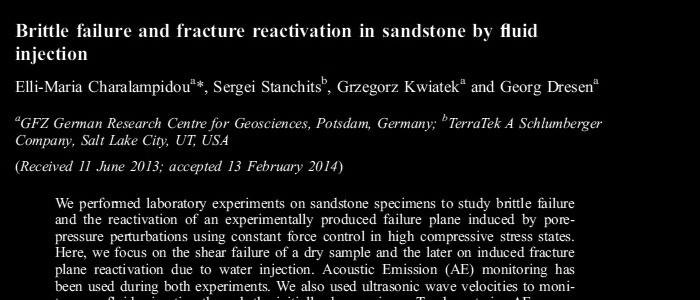We published a paper in European Journal of Environmental and Civil Engineering on analysis of acoustic emission data in fracture and fluid-injection experiments in sandstone. Here is the reference:
Kwiatek, G., Charalampidou, E.-M., Dresen, G., and S. Stanchits (2014). An improved method for seismic moment tensor inversion of acoustic emissions through assessment of sensor coupling and sensitivity to incidence angle. Int. J. Rock Mech. Min. Sci. 65, 153-161, DOI: 10.1016/j.ijrmms.2013.11.005 [ Article Page ]
Abstract:
We performed laboratory experiments on sandstone specimens to study brittle failure and the reactivation of an experimentally produced failure plane induced by pore-pressure perturbations using constant force control in high compressive stress states. Here, we focus on the shear failure of a dry sample and the later on induced fracture plane reactivation due to water injection. Acoustic Emission (AE) monitoring has been used during both experiments. We also used ultrasonic wave velocities to monitor pore fluid migration through the initially dry specimen. To characterise AE source mechanisms, we analysed first motion polarities and performed full moment tensor inversion at all stages of the experiments. For the case of water injection on the dry specimen that previously failed in shear, AE activity during formation of new fractures is dominated by tensile and shear sources as opposed to the fracture plane reactivation, when compressive and shear sources are most frequent. Furthermore, during the reactivation of the latter, compressive sources involve higher compressive components compared to the shear failure case. The polarity method and the moment tensor inversion reveal similar source mechanisms but the latter provides more information on the source components.
